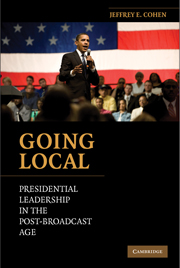Book contents
- Frontmatter
- Contents
- List of Figures
- List of Tables
- Introduction
- 1 Context and Presidential Leadership Styles
- 2 Increasing Presidential Attention to Narrow Groups
- 3 Presidents and the Local News Media
- 4 A Theory of Presidential News Management and Local News Coverage
- 5 The Quantity of Local Newspaper Coverage of the President
- 6 Trends in Local Newspaper Coverage of the Presidency, 1990–2007
- 7 On the Tone of Local Presidential News
- 8 Local Presidential News Coverage and Public Attitudes toward the President
- 9 Conclusions: Presidential Leadership in the Post-Broadcast Age
- Bibliography
- Index
2 - Increasing Presidential Attention to Narrow Groups
Published online by Cambridge University Press: 05 June 2012
- Frontmatter
- Contents
- List of Figures
- List of Tables
- Introduction
- 1 Context and Presidential Leadership Styles
- 2 Increasing Presidential Attention to Narrow Groups
- 3 Presidents and the Local News Media
- 4 A Theory of Presidential News Management and Local News Coverage
- 5 The Quantity of Local Newspaper Coverage of the President
- 6 Trends in Local Newspaper Coverage of the Presidency, 1990–2007
- 7 On the Tone of Local Presidential News
- 8 Local Presidential News Coverage and Public Attitudes toward the President
- 9 Conclusions: Presidential Leadership in the Post-Broadcast Age
- Bibliography
- Index
Summary
The context theory of presidential leadership styles argues that in the current age of polarized parties and fragmented media, presidents still go public, but differently than in the age of individual pluralism. Rather than focus their energies on the mass public writ broadly, presidents have shifted much of their leadership efforts to narrower segments of the public, in particular their party base, interest groups, and localities. These segments function much like national public opinion did in the age of individual pluralism; that is, they put pressure on members of Congress to support the president.
Several hypotheses flow from the context theory of presidential leadership. First, presidents will give greater attention to these three segments in the current era of polarized parties and fragmented media than they did during the era of individual pluralism. Second, the relative amount of effort applied to influencing national opinion – for instance, through national prime-time addresses – will decline. This chapter tests these hypotheses.
The context theory also argues that presidents updated their going public leadership style because a nationally based style was declining in effectiveness, but the targeted approach to going public could prove effective. Succeeding chapters will test the effectiveness hypothesis as it pertains to localities. As argued in more detail later, local news media, in particular local newspapers, are an important element in trying to influence local opinion. Can presidents influence the news coverage they receive from local newspapers, and does that coverage affect public support for the president?
- Type
- Chapter
- Information
- Going LocalPresidential Leadership in the Post-Broadcast Age, pp. 35 - 53Publisher: Cambridge University PressPrint publication year: 2009



